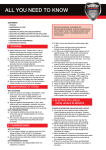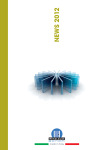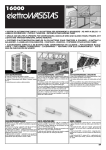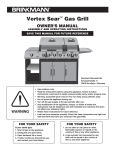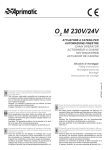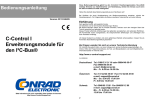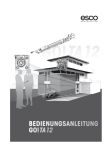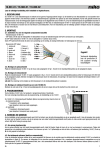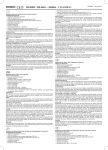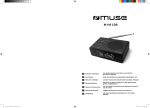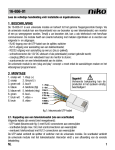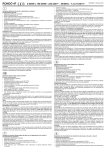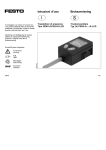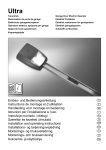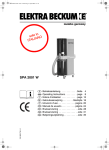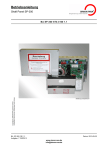Download Betriebsanleitung ProSense
Transcript
1 SIMON RWA Systeme GmbH Medienstr. 8 D- 94036 Passau Tel. +49 851 98870-0 Fax: +49 851 98870-70 E-mail: [email protected] Internet: http://www.simon-rwa.de Ausgabe: C - 01/11 Produktinformation Schlitzantrieb Typ EA-LS-1000/48-PS Lesen und beachten Sie die Angaben in dieser Produktinformation! Systembeschreibung Vermeiden Sie dadurch Schäden und Gefahren! Bewahren Sie die Produktinformation für den späteren Gebrauch (z. B. Wartung) auf! Elektromotorische Fernbedienung von Lamellenfenstern zur Rauch - und Wärmeableitung, sowie zu Lüftungszwecken. Einsetzbar mit RWA - und/oder Lüftungssteuerungen der SIMON RWA Systeme GmbH. Der Schlitzantrieb ist mit einem integrierten elektronischen Klemmschutz (ProSense®) ausgerüstet. Allgemein: Kraftbetätigte Fenster, die (auch nur mit Teilen des Fensters) tiefer als 2,5 m über OKFFB (Oberkante Fertigfussboden) liegen, bedürfen einer Risikoeinschätzung im Hinblick auf Quetsch- und Klemmgefahren. Mehrere nationale und internationale Vorschriften regeln die je nach Nutzungsart des Fensters notwendigen Schutzmassnahmen. Es wird eine Risikoeinschätzung durchgeführt. Entsprechend der Einbausituation, der Nutzung des Gebäudes und der verwendeten Steuertechnik wird eine Schutzklasse definiert. Diese ist dann Grundlage für die entsprechenden Schutzmassnahmen. Wir bieten Ihnen mit unserem System ProSense® eine technisch optimierte und qualitativ hochwertige Lösung zur Erfüllung dieser Forderungen. Haftung: Der Bauplaner/Architekt, bzw. die ausschreibende Stelle müssen die Anforderungen an kraftbetätigte Fenster eindeutig vorgeben. Hierzu gehört die Abstimmung mit den zuständigen Behörden (z. B. Bauamt) ggf. bei gewerblicher und öffentlicher Nutzung unter Beteiligung des zuständigen Unfallversicherungsträgers. Der Auftraggeber, der das kraftbetätigte Fenster errichtet, ist verantwortlich für die Einhaltung der Ausschreibung unter Beachtung der technischen Regeln und dem Stand der Technik. Der Auftraggeber/Betreiber/Nutzer hat dafür Sorge zu tragen, dass kraftbetätigte Fenster gemäß der Benutzerinformationen/ Betriebsanleitungen betrieben und unterhalten werden. 2 Wissenswertes: Bei ProSense® handelt es sich um eine elektronische Eingriffsicherung für kraftbetätigte Fenster an den Hauptschließkanten. Das System ProSense® ist eine spezielle Elektronik zum Klemmschutz für 24 V DC Antriebe und ist direkt im Antrieb verbaut. Der Einsatz dieser Systembe- Technik setzt eine Testreihe und kundenspezifische Parametrierung der Software an einem schreibung Originalmuster im Werk Passau voraus. Um den optimalen Klemmschutz gewährleisten zu können, erfolgt die Fertigung der Antriebe in Abstimmung mit den technischen Anforderungen, resultierend aus den vorangegangenen Tests. Funktionsweise ProSense®: Durch eine intelligente Elektronik “lernt” der Antrieb innerhalb von 5 Lernfahrten am jeweiligen Fenster (diese müssen zwingend bei der Installation durchgeführt werden) wie groß der Kraftbedarf ist (über Strommessung des Antriebs) und regelt diesen für den kompletten Öffnungsweg auf ein Optimum. Im Bereich des Klemmschutzes wird diese definierte Kraft ständig mit der IST-Kraft verglichen. Wenn nun eine ungewöhnliche Abweichung festgestellt wird, z. B. durch ein eingeklemmtes Körperteil, reagiert die Elektronik. Diese öffnet das Fenster einige Zentimeter und schaltet den Motor ab. Die Kraftabweichung ist durch einen Parameter fest definiert. Der Antrieb kann nun nur noch in Richtung AUF bewegt werden. Der überwachte Einklemmbereich erstreckt sich von der Hauptschließkante bis etwa 200 mm des geöffneten Fensters. Die ProSense®-Funktion ist beim Anfahren des Antriebes ausgeschaltet und wird erst nach der Startphase wieder eingeschaltet. Wurde der Einklemmschutz aktiviert, wird die Schließkraft beim nächsten Schließvorgang erhöht. Um dieselbe Sensibilität wie vor dem Einklemmen zu erreichen sind ca. 5 störungsfreie Fahrzyklen in ZU-Richtung nötig bis der Antrieb in Endlage ZU selbsttätig abschaltet. Um ein Dichtschließen des Fensters gewährleisten zu können, wird die Funktion ProSense® einige mm vor dem komplett geschlossenen Fenster ausgeschaltet. Der Antrieb zieht das Fenster somit sicher in seine Dichtung. In Richtung AUF ist diese Funktion ausgeschaltet. Das System “lernt” über seinen gesamten Lebenszyklus ca. 11 000 Zyklen den Kraftbedarf des Fensters, das bedeutet eine Verschlechterung oder Verbesserung der Mechanik des Fensters wird ausgeglichen. Die Kraftabweichung bleibt aber unverändert und somit bleibt auch die Sensibilität erhalten. Achtung! Der Einbau von technischen Einrichtungen wie Pro Sense® dienen dem Schutz der Personen, die mit dem kraftbetätigten Fenster in Verbindung kommen. Er kann aber nicht organisatorische Maßnahmen kompensieren, die ergriffen werden müssen um einen optimalen Klemmschutz zu erreichen. Insbesondere befreit der Einbau technischer Hilfsmittel den Planer und Errichter nicht von der Notwendigkeit einer Risikobeurteilung und der Ergreifung der sich daraus ergebenden notwendigen Maßnahmen. Die Klemmschutzelektronik wird nur in ZU-Richtung aktiviert. Damit der Einklemmschutz zuverlässig funktioniert, müssen nach der Erstinstallation zwingend 5 vollständige Fahrzyklen absolviert werden. Der Antrieb muss jeweils in den Endlagen selbsttätig abschalten. Danach ist der Einklemmschutz optimal eingestellt und betriebsbereit! 3 F-Kontaktfunktion: Für AUF- und ZU-Richtung: Systembe- Wird der Schlitzantrieb durch Überlast oder bei Erreichen des elektronischen Hubs in der schreibung Fahrtrichtung AUF, bzw. Fahrtrichtung ZU abgeschaltet, wird der F-Kontakt wie bei “Technische Daten” und “Elektrischer Anschluss” beschrieben ausgegeben. 1.) Typ. / Version: EA-LS-1000/48-PS 2.) Bemessungsspannung [V DC]: +24 V; +20 %; -10 % Technische 3.) Restwelligkeit [Vss]: Daten Allgemein 4.) Bemessungsstrom [A]: < 500 mV 1,1 A 5.) Abschaltstrom [A]: max. 1,1 A 6.) Maximalstrom [A]: ca. 2,8 A 7.) Einschaltdauer [%]: ED 30; bezogen auf 10 min. 8.) Nennhubgeschwindigkeit [mm/s]: 4,3 mm/s 9.) Leerlaufhubgeschwindigkeit [mm/s]: 5,2 mm/s 10.) Hubgeschwindigkeit 2/3 Last [mm/s]: 4,7 mm/s 11.) Hubtoleranz [%]: +/- 5 % 12.) Nennschubkraft [N]: 1000 N 13.) Max. Schubkraft [N]: 1000 N 14.) Max. Zugkraft [N]: 1000 N 15.) Hublängen lieferbar [mm]: 48 mm 16.) Schutzart [IP]: IP 20 17.) Lebensdauer [Zyklen] Öffnungs- und Schließzyklen: 18.) Umgebungstemperaturbereich [°C]: 19.) Temperaturstandsicherheit: 10 000 Lüftung + 1000 RWA -5° C bis +75° C Temperatursicherheit 30 min. / 300°C 4 20.) Material Schubrohr: Aluminium, EV1 21.) Material Antriebsgehäuse: Aluminium, EV1 Technische 22.) Einbaumass Motor (B x H); [mm]: Daten Allgemein 23.) Anschlussleitung [m]: 400 mm x 36 mm x 46 mm 2 000 mm ; 5-polig; 0,75 mm2; Silicon SIR/SIR-SO-EWKF lichtgrau 24.) Umpolzeit zwischen "S", "O" [ms]: > 500 ms 25.) Schallpegel [dB] im Abstand von 1 m: 26.) F-Kontakt ( "S" Weiterleitung) Bemessungsspannung [V DC]: Kontaktbelastung Relais [V DC]; [A]: < 70 dB 24 V; +20 %; -10 % max. 30 V; max. 2 A Zu 6.) Der Maximalstrom des Schlitzantriebes wird im Einklemmfall beim Reversiervorgang nicht begrenzt Zu 15.) Hub begrenzbar Zu 20.), 21.) Aluminium eloxiert (farblos) Zu 26.) Beim F-Kontakt wird immer das Potential der Klemme „S“ ausgegeben, d.h. wenn „S“ Minus führt wird Minus weitergeleitet und wenn “S“ Plus führt wird Plus weitergeleitet Bitte berücksichtigen Sie vor der Montage folgende wichtige Informationen! Der Antrieb ist mit einer mikroprozessorgesteuerten Abschaltung ausgestattet und bietet Ihnen weitere Sonderfunktionen an. Bei dem vorliegenden Fertigungsstand können Sie serienmäßig folgende Sonderfunktionen verwenden: Wichtige Information Elektronische Endlagenerkennung: Wenn der Antrieb in seine Endlage ZU gefahren ist und von der Versorgung getrennt wird, bewirkt ein erneutes Ansteuern in die Richtung ZU keinen neuen Motoranlauf. In diesem Fall muss der Antrieb erst in Richtung AUF angesteuert werden um wieder aus seiner Endlage herauszufahren. In Richtung AUF gilt diese Funktion sinngemäß ebenso. Dies bietet einen größtmöglichen Schutz vor Getriebeschäden durch Fremdansteuerung (z. B. GLT, LON). Wichtig: Zu beachten sind die VDE 0833 für Gefahrenmeldeanlagen, VDE 0100 für elektrische Anlagen, DIN 18232 (EN 12101-2) für RWA - Anlagen, die Bestimmung der örtlichen Feuerwehr und des EVU für den Netzanschluss, sowie BGV A3 und BG Regel BGR 232. Gefahrenhinweise Bitte beachten: Kraftbetätigte Fenster dürfen nicht im Griffbereich liegen. Quetschgefahr! Es sind die Vorschriften (BGR 232) des Hauptverbandes der gewerblichen Berufsgenossenschaften zu berücksichtigen. 5 Die Montage muss grundsätzlich von geschultem Fachpersonal durchgeführt werden. Erst nach Überprüfung der gesamten Anlage, an die 24 V Versorgung anschließen. Der Antrieb ist mit einem elektronischen Überlastschutz ausgestattet. Achtung: Der Antrieb darf nur mit 24 V Schutzkleinspannung betrieben werden! Die Energieversorgung muss für den Antrieb ausgelegt sein. Höhe und Qualität der Spannung und Stromstärke müssen mit den Angaben auf dem Typenschild übereinstimmen. Vor der ersten Inbetriebnahme ist die Zuleitungsverkabelung zu kontrollieren. Dabei ist insbesondere der Aderquerschnitt zu berücksichtigen. Aderquerschnitt: [mm2 ] = 0,019 x Motorenzahl x Stromaufnahme pro Motor [A] x Leitungslänge [m] (bei Trafo - Primärspannung von 230 V und Temperatur 25° C) 1. Antrieb M 24 V DC O AM-874 F Braun S Blau C Rot (max. +5V DC) P Gelb (0 V) AUF: S = + O=ZU: umpolen Schwarz MC 24V DC Elektrischer Anschluss + (-) - (+) Parallelbetrieb von max. 4 Antrieben möglich Achtung ProSense®: Die interne Steuerelektronik gibt nach dem Abschalten des Antriebes jeweils das Potenzial von (S) auf den Rückkontakt (F). Potenzialfortschaltung (z.B. Rückmeldung) über “F”-Kontakt (Schwarz). Die Adern (C und P) dürfen nicht verbunden werden und müssen elektrisch isoliert werden. (Schwarz) muss je nach Anwendung elektrisch isoliert werden! Auf eine dauerhafte und mindestens für die auf dem Typenschild angegebene Motorkraft ausgelegte Befestigung des Antriebes am Fenster - bzw. Flügelrahmen ist zu achten. 6 Für die nachfolgend beschriebene Inbetriebnahme ist das Resetgerät mit der Artikelnummer M2 3400 aus dem SIMON RWA Systemprogramm notwendig. Das Resetgerät erhalten Sie bei unseren Vertriebspartnern oder direkt beim Hersteller. Montage/ Inbetriebnahme 1. Den Antrieb elektrisch anschließen lt . Produktbeschreibung (Schaltbild). 1.1 1.2 1.3 1.4 1.5 1.6 1.7 1.8 1.9 1.10 1.11 1.12 1.13 1.14 1.15 1.16 1.17 1.18 1.19 1.20 1.21 1.22 1.23 Den Antrieb stoppen (S und O spannungsfrei setzen). Die Grundstellung des RESET Geräts ProSense® prüfen > EIN/AUS in AUS; RESET/TEST auf TEST Die rote Ader des Antriebskabels an die rote Buchse des RESET Gerätes anschließen. Die gelbe Ader des Antriebskabels an die gelbe Buchse des RESET Gerätes anschließen. Schalter EIN/AUS in EIN schalten > In dieser Schalterposition besteht die Möglichkeit die COM Spannung zu messen. Schalter RESET/TEST auf RESET schalten > In der Anzeige muss ein Spannungswert von 4,65 V DC +/- 0,05 V DC angezeigt werden, bei Abweichung ist die Batteriespannung zu prüfen oder das Gerät zur Kalibrierung ins Werk einsenden. Den Antrieb in AUF-Richtung ansteuern - der Antrieb muss in ZU-Richtung fahren und befindet sich somit im Resetmodus. Der Antrieb muss solange angesteuert werden, bis er selbstständig abschaltet. Den Antrieb stoppen (S und O spannungsfrei setzen). Schalter RESET/TEST auf TEST schalten. Schalter EIN/AUS auf AUS schalten. Der Nullabgleich ist abgeschlossen. COM Spannung über Hub kontrollieren > Schalter RESET/TEST auf TEST schalten. Schalter EIN/AUS auf EIN schalten. Antrieb in ZU ansteuern. Anzeige muss einen Spannungswert zwischen 0,47 V DC bis 0,50 V DC ausgeben. Antrieb unter Beachtung der Umpolzeit von > 500 ms in AUF ansteuern. Spannungswert der Anzeige steigt bis 100 % Hub auf 4,45 V DC +/- 0,15 V DC Antrieb unter Beachtung der Umpolzeit von > 500 ms in ZU ansteuern. Spannungswert der Anzeige sinkt bis Grundstellung. Nach Abschaltung des Antriebs muss die Anzeige einen Spannungswert zwischen 0,47 V DC bis 0,50 V DC ausgeben. Schalter EIN/AUS auf AUS schalten. Anschlusskabel gelb/rot abklemmen und isolieren. 2. Den Antrieb mindestens 5 Zyklen in AUF und ZU-Richtung ansteuern (Lernphase). In der Lernphase muss der Antrieb immer bis in die Endlage gefahren sein und solange angesteuert werden bis er selbsttätig abschaltet. Die Klemmschutzelektronik wird nur in ZU-Richtung aktiviert. Hinweis: Kommt es durch äußere Umstände zu einer Verstellung der Position des Antriebes, muss ein Reset durchgeführt werden. Bei dieser Resetfahrt wird der Nullpunkt des Fensters neu eingestellt und der gelernte Kraftbedarf des Fensters wird auf die Maximalwerte (Auslieferungszustand) zurückgesetzt. Reset wie unter Punkt 1 durchführen. 7 Die Montage muss grundsätzlich von geschultem Fachpersonal durchgeführt werden! Auf eine dauerhafte und mindestens für die auf dem Typenschild angegebene Motorkraft ausgelegte Befestigung des Antriebes am Rahmen des Lamellenelementes ist zu achten. Montagehinweise Montageablauf Lamelle TG 24 Anschlusskabel 1. Der Antrieb wird grundsätzlich im geschlossenen Zustand (ZU - Richtung) ausgeliefert. 2. Der auf die Grundplatte vormontierte Antrieb, wird auf die bauseitige Montageplatte befestigt. Die Montage erfolgt bei geschlossener Lamelle. Antrieb Grundplatte bauseitige Montageplatte Positionierung des Antriebes AUF - Richtung Lamellenzapfen 3. Eine Feinjustierung des Antriebes erfolgt durch das Lösen der seitlichen Gewindestifte. Gewindestifte 4. Nach der Justierung die seitlichen Gewindestifte fest anziehen. 8 EG-Herstellererklärung Hiermit erklären wir die Konformität des Produktes mit den dafür geltenden Richtlinien. Die Konformitätserklärung kann in der Firma eingesehen werden und wird Ihnen auf Anforderung zugesandt. Bei einer nicht mit uns abgestimmten Änderung verliert diese Erklärung ihre Gültigkeit. Firmenanschriften Deutschland: Simon RWA® Systeme GmbH Medienstr. 8 D - 94036 Passau Tel.: +49 (0)851 98870 - 0 Fax: +49 (0)851 98870-70 E-Mail: [email protected] Internet: www.simon-rwa.de Schweiz: Österreich: Simon RWA® Systeme AG Allmendstrasse 8 CH - 8320 Fehraltorf Tel.: +41 (0)44 956 50 30 Fax: +41 (0)44 956 50 40 E-Mail: [email protected] Internet: www.simon-rwa.ch Simon RWA® Systeme GmbH Aumühlweg 21 Top 313/314 A - 2544 Leobersdorf Tel.: +43 (0)2256 64001 Fax: +43 (0)2256 64070 E-Mail: [email protected] Internet: www.simon-rwa.at 8 EC-Manufacturer’s declaration We herewith declare the conformity of the product with the applicable directives. The declaration of conformity can be viewed at the company and is mailed to you upon request. This declaration is rendered invalid with any changes not agreed to by us. Company addresses Germany: Simon RWA® Systeme GmbH Medienstr. 8 D - 94036 Passau Tel.: +49 (0)851 98870 - 0 Fax: +49 (0)851 98870-70 E-Mail: [email protected] Internet: www.simon-rwa.de Austria: Simon RWA® Systeme GmbH Aumühlweg 21 Top 313/314 A - 2544 Leobersdorf Tel.: +43 (0)2256 64001 Fax: +43 (0)2256 64070 E-Mail: [email protected] Internet: www.simon-rwa.at Switzerland: Simon RWA® Systeme AG Allmendstrasse 8 CH - 8320 Fehraltorf Tel.: +41 (0)44 956 50 30 Fax: +41 (0)44 956 50 40 E-Mail: [email protected] Internet: www.simon-rwa.ch 7 The installation may only be accomplished by technical specialists. Please see that the fastening of the actuator on the louvre window is durable and dimensioned at least for the actuators force mentioned on the type label. Installation options Mounting process glass louvre TG 24 connecting cable actuator 1. Basically the acuator is delivered in closed state. (CLOSE -Alignment) 2. Being pre-installed to the bottom plate the actuator is fastened to the mounting plate (provided by the building contractor). The glass louvre is closed during assembly. bottom plate mounting plate by the building contractor glass louvre pivot OPEN - Alignment positioning of the actuator threaded pins 3. The detachment of the lateral threaded pins causes a precise adjustment of the actuator. Attention: The actuator has to be positioned according to the arrow’s route and has to be regulated in that way that the actuator runs directly into it’s cut off decrease. The cut off may not exceed the fixing (end position) of the glass louvre element! 4. Attach the lateral threaded pins tightly after the adjustment. The dimension of power supply has to be suitable for this actuator. Both voltage and current must agree with the specifications on the “Technical Data General”l. Please check all cables, especially the cable cross section, before putting it into operation. Electrical connection Cable cross section [mm²] = 0,019 x number of actuators x current of actuator [A] x cable length [m] (at a transormer-primary voltage of 230 V and temperature 25° C) 6 For the operation described below the RESET device with the part number M2 3400 from SIMON RWA system program is necessary. You will get the RESET device from our distributors or directly from the manufacturer. Installation German/English definition: EIN = ON / AUS = OFF / AUF = OPEN / ZU = CLOSE 1. Connect the actuator electrically as described in Additional Information (diagram). 1.1 Stop the actuator (set S and O zero-potential). 1.2 Check the switches of the RESET device. EIN/AUS to AUS and RESET/TEST to TEST 1.3 Connect the red wire of the power cable to the red jack at the RESET device. 1.4 Connect the yellow wire of the power cable to the yellow jack at the RESET device. 1.5 Switch ON / OFF switch in ON> in this switch position it is possible to measure the COM voltage. 1.6 Set RESET/TEST switch to RESET > The display must show the voltage value 4,65V DC +/- 0,05 V DC. If not please check the battery voltage or send the device back to factory for calibration. 1.7 Power the actuator in OPEN-direction, but it has to run in CLOSE direction because of RESET mode. So you will be sure the RESET mode is set. 1.8 The actuator must be powered until it shuts off automatically. 1.9 Stop the actuator (set S and O zero-potential). 1.10 Switch RESET/TEST to TEST. 1.11 Switch EIN/AUS to AUS. 1.12 The zero adjustment is completed. 1.13 Control COM voltage by the stroke> switch RESET/TEST to TEST 1.14 Switch EIN/AUS to EIN 1.15 Power the actuator in CLOSE direction 1.16 Display has to show a voltage value between 0,47 V DC and 0,50 V DC 1.17 Power the actuator by attention of the pole change time > 500ms in OPEN direction 1.18 The display voltage value has to increase until 100% stroke to 4,45 V DC +/- 0,15 V DC 1.19 Power the actuator by attention of the pole change time > 500ms in CLOSE direction 1.20 voltage value of the indicator drops to normal position. 1.21 After switching off the actuator the display has to show a voltage value between 0.47 V DC to 0.50 V DC. 1.22 Switch EIN/AUS to AUS. 1.23 Disconnect power cable yellow / red and isolate them 2. Run the actuator at least 5 cycles in direction OPEN and CLOSE (Learning phase). In the learning phase the actuator must always run up to the end position and has to be controlled until it switches off automatically. The squeeze protection electronics are activated only in the CLOSE direction. Attention: If the position of the actuator is adjusted by external circumstances you have to do a RESET. With a complete RESET operation the setup point of the window is adjusted new and the learned force requirements are set back to maximum (delivey status). RESET as explained in chapter 1. 5 With hoppers outward opening, one shearing action must be additionally applied to the window drive for limiting tilting motion of the window wing after the actuator in unhinged, e.g. for cleaning window, so safeguarding the wing against hinging down. This stop position must be somewhat larger than stroke of the drive. The shearing action must be applied before beginning with actuator mounting. Installation The spindle actuator must be installed with the stepless adjustable bracket set (UK-L or HK-L) wich is fixed with a clamping collar to the actuator pipe. The actuator is equipped with an electronic overload cut off and a limit dumping to protect the actuator and provide durability. 1. Actuator M 24 V DC MC Open: S = + O=Close: pole change 24V DC P Yellow(0 V) C Red (max. +5V DC) S Blue F O Brown Black AM-874 + (-) - (+) Parallel operation of max. 4 actuators possible Attention ProSense: In the end position or by overload the integrated electronics switches potential (S) to (F) (e.g. for signal). The red (C ) and yellow (P) cores are only used for resetting the actuator by the reset-device. Do not connect (C and P). These cores have to be insulated. If F (black) is not used please insulate. A durable and is designed for at least the nameplate on the engine mounting strength of the actuator by the window - or sash to be respected. 4 Aluminium, anodizedEV1 21.) Material housing: Aluminium, anodized EV1 20.) Material sheare tube: 22.) Motor mounting dimension (B x H); [mm]: Technical Data 23.) Connecting cable [m]: General 24.) Pol change time between "S", "O" [ms]: 25.) Noise level [dB] at a distance of 1 m: 26.) F-Contact ( "S" forwarding) Rated voltage [V DC]: Contact load relay [V DC]; [A]: 400 mm x 36 mm x 46 mm 2 000 mm ; 5-pin; 0,75 mm2; Silicon SIR/SIR-SO-EWKF light grey > 500 ms < 70 dB 24 V; +20 %; -10 % max. 30 V; max. 2 A App. 6.) The maximum current is not limited in case of squeezing App. 15.) Stroke can be limited App. 20.), 21.) Aluminium anodized (colorless) App. 26.) The F-contact is always the potential of the terminal "S" output, i.e. if "S" Minus ,then the output is also Minus, and if "S" Plus then issued Plus Important: For placing this product on the market outside of Germany the installation and use has to follow all relevant and valid directives of the respective country! Attention Please consider: Force operated windows may not be located within the reaching area of hands. Bruising danger! The commandments of the association of commercial and industrial workers’ compensation insurance carriers have to be considered! The function of the system must be tested periodically by the customer. In case of defect the installer has to be informed at once. Please change defect parts immediately with original parts. The system as well as components of a system may just be opened by the manufacturer. Material defects: The device must be used as normally intended. The switch-on duration and the ingress protection (IP) must be observed, please inquire in case of doubt. The device is subject to natural wear and tear. In case of material defect claims, these shall be asserted in writing, stating the source of supply of the device. Prescribed time limits and further provisions with regard to claims for material defects exclusively correspond with our General Terms and Maintenance Condition. This device must be disposed properly at the end of its life time. Disposal 3 F-Contact function: For OPEN and direction: If the slit actuator through overload or when reaching the electronic stroke in the direction OPEN or CLOSE direction switched off, the F-contact as in "Technical Data General” and System Description "Installation" output. 1.) Typ. / Version: 2.) Rated voltage [V DC]: 3.) Ripple [Vss]: Technical Data General 4.) Rated current [A]: EA-LS-1000/48-PS +24 V; +20 %; -10 % < 500 mV 1,1 A approx. 2,8 A 6.) Maximal current [A]: max. 1,1 A 5.) Switch of current [A]: 4,7 mm/s 10.) Lifting speed 2/3 weight [mm/s]: 5,2 mm/s 9.) Lifting speed idle [mm/s]: 4,3 mm/s 8.) Nominal speed [mm/s]: ED 30; at 10 min. 7.) Switch on duration [%]: 48 mm 15.) Stroke [mm]: 1000 N 14.) Max. traction force [N]: 1000 N 13.) Max. shear strength [N]: 1000 N 12.) Nominal shear strength [N]: +/- 5 % 11.) Lifting speed tolerance [%]: 16.) Protection [IP]: 17.) Lifetime [Cycles] open- and close cycles: 18.) Temperature range [°C]: 19.) Temperature stability: IP 20 10 000 Ventilation + 1000 SHE -5° C to +75° C Security temperature for 30 min. / 300°C 2 Trivia: ProSense® is an electronic protection at the main closing edge of power operated windows. The system ProSense® is a special electronics for squeezing protection for 24 V DC actuators and is installed directly in the actuator. The use of this technique requires a series of tests and customization of software parameters in an original model in manufacturing in Passau, System Description Germany. To ensure the optimal squeezing protection, the production of the actuator is made in consultation with the technical requirements resulting from the previous tests. Mode of Operation of ProSense®: By the use of intelligent electronics the actuator "learns" within five learning cycles at the specific window (which must necessarily be carried out during installation) how big the power consumption is (over current measurement of the actuator) and controls it for the complete stroke as an optimum. In the area of the squeezing protection this known force will be compared with the current force during the whole closing process. Now if an unusual deviation is found, for example by a pinched part of the body, the electronics react. This opens the window a few mm and stops the acuator. The force deviation is defined by a parameter set. The drive can now be moved only in the direction OPEN. The monitored area of the squeezing protection extends from the main closing edge to about 200 mm stroke of the open window. While starting the actuator The ProSense® is turned off and turns on after this starting phase. If the protection is enabled the force at the next closing will be increased. In order to achieve the same sensitivity as before about five trouble-free cycles in CLOSE direction are needed for an automatically power down of the actuator if it is in end position CLOSED. To ensure as sealing closing of the window, ProSense® switches itself off a few mm before the window is completely closed. So the actuator moves the window safe in the window’s seal. In direction OPEN ProSense® is disabled. The system "learns" over its entire life cycle (about 11 000 cycles) the power requirements of the window, which means a deterioration or improvement of the mechanics of the window is cleared. The force deviation remains unchanged and thus remains the sensitivity obtained. Caution! The installation of technical equipment such as ProSense® protect people who get in contact to force-operated windows. But it can not compensate for organizational activities wich have to be taken to achieve an optimal squeezing protection. In particular the installation of technical aids does not release the planners and builders of the need for risk assessment and execution of the resulting necessary measures. The squeezing protection electronics are activated only in CLOSE direction. For a reliable anti-trap function the system run mandatory five complete cycles after the initial installation. The actuator must switch off automatically at the end position. Thereafter the squeezing protection is optimally set and ready! 1 SIMON RWA Systeme GmbH Medienstr. 8 D- 94036 Passau Tel. +49 851 98870-0 Fax: +49 851 98870-70 E-mail: [email protected] Internet: http://www.simon-rwa.de Edition: B - 07/10 User Manual slit actuator type EA-LS-1000/48-PS Please take notice about the content of this manual! To avoid damage and injury! Please retain this manual for later use (manual ...) It is motorized remote control of louvre windows for smoke and heat ventilation, as well as for ventilation range. It can be used with SHE - and / or ventilation controls of our system program. The slit actuator is equipped with an integrated electronic squeeze protection (ProSense®). System General: Describtion Force-operated windows, which are installed lower (even with parts of the window) than 2.5 m above finished floor level require a risk assessment with a view to squeezing dangers. Several national and international regulations govern the necessary protective measures according to the type of use of the window. The system performs a risk assessment. According to the installation situation, the use of the building and the used control technique of protection has to be defined. This is the basis for the appropriate protective measures. With our system ProSense® we offer you a technically optimized and high quality solution to meet these demands. Liability: The building planners / architect or the tender offering office must purport the requirements for the force-operated windows. To this issue belongs the trade-off with the competent authorities (such as construction administration) and if necessary under attendance of competent accident insurance fund by commercial and public use. The client, who is building the power operated window, is responsible for compliance with the tender in attention of technical rules and the state of the art. The client / owner / user is responsible to ensure that power-operated window are used and maintained according to the user information / manuals.
















